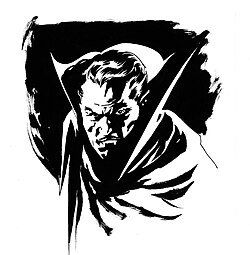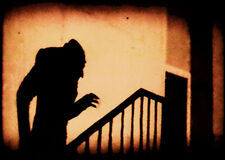
Dracula is an 1897 horror novel written by the Irish author Bram Stoker. The title character is the vampire Count Dracula. There have been numerous stage, film, radio, television and comic book adaptations.
Inspiration
According to legend, a vampire is a reanimated corpse which feeds on human blood, can take the form of some animals, such as bats and wolves, and neither casts a shadow or a reflection in a mirror. The popular understanding of the vampire myth has changed slightly since Dracula was first published. In the novel, Dracula is able to go out in the daytime and is killed by having his head cut off, not with a stake through his heart.
The character of Dracula was inspired by the historical figure known as Vlad Drakul (Vlad the Dragon) or Vlad Tepes (Vlad the Impaler).
Plot
The majority of the novel is written in the first person. Most of it takes the form of entries from the main characters' diaries.
At the beginning of the novel, the reader is introduced to Jonathan Harker, a young lawyer who has recently become engaged to Wilhelmina (Mina) and is en route to visit Count Dracula.The company that Harker works for has sold the Count an abandoned house in London. Harker stays at Dracula's castle, soon realising that he is a prisoner there and that his host is not human. Eventually, Harker manages to escape.

The setting then moves to Whitby, England and the narrative is continued through Mina's diary. Mina expresses her love for Jonathan and her concerns when he stops writing to her. The reader is also introduced to Lucy Westenra, Mina's best friend, and the three young men who wish to marry her: the American cowboy Quincy Morris, Lord Arthur Holmwood and Doctor Seward who runs an insane asylum. Doctor Seward's diary introduces the reader to Renfield, a lunatic who eats flies, then spiders, then rats, because he believes that he will absorb their lives.
Lucy begins to sleepwalk and become ill from loss of blood. Doctor Seward contacts Abraham Van Helsing, a Dutch doctor who is also an expert in folklore and mythology, to treat Lucy. It is only after Lucy has died and become a vampire that Van Helsing explains everything to the other characters, including Jonathan Harker who has returned to England.
Dracula then turns his attentions towards Mina, who begins to become vampirized and develops a psychic bond with Dracula. Van Helsing declares that the only way to prevent Mina from becoming a vampire is to destroy Dracula.
Dracula is pursued back to his home in Transylvania. In a final struggle, in which Quincy Morris is killed, Dracula is destroyed and the curse on Mina is lifted.
Adaptations

The novel Dracula provided the inspiration for a great many stage plays, radio plays, comic books and television specials and series. Many other works have featured the vampire Count Dracula as a character. According to the Internet Movie Database, Count Dracula has been featured in two hundred and seventeen different films. Sherlock Holmes, with two hundred and twenty-three film appearances, is the only fictional character to have appeared in more films than Count Dracula.
The 1922 German silent movie Nosferatu, directed by F.W. Murnau and starring Max Schreck as the vampire, was the first film adaptation of Dracula. The widow of Bram Stoker took legal action against the makers of Nosferatu for violation of copyright. As a result, the film-makers were forced to change the characters' names; Count Dracula becoming Count Orlok. Nosferatu differs from the novel Dracula in a number of ways, for example, the characters of Lucy and Mina are combined and the arrival in town of the vampire is accompanied by the arrival of bubonic plague. Nosferatu introduced the idea that vampires are destroyed by sunlight, a concept not found in Bram Stoker's novel. Nosferatu has been officially remade three times, as the 1979 West German film Nosferatu the Vampyre directed by Werner Herzog, as the 2023 American film Nosferatu: A Symphony of Terror directed by David Lee Fisher and as the 2024 American film Nosferatu directed by Robert Eggers.
In 1931 Universal Pictures released Dracula directed by Tod Browning and starring Hungarian-born actor Bela Lugosi as the title character. Five sequels followed: Dracula's Daughter (1933), Son of Dracula (1943), House of Frankenstein (1944), House of Dracula (1945) and the comedy Abbott and Costello Meet Frankenstein (1948). However, it was only in Abbott and Costello Meet Frankenstein that Lugosi returned to play Dracula.

In 1958 Britain's Hammer Film Productions produced Dracula (released in the United States as Horror of Dracula), directed by Terence Fisher, starring Christopher Lee as Count Dracula and Peter Cushing as Van Helsing. Eight sequels followed: The Brides of Dracula (1964), Dracula; Prince of Darkness (1966), Dracula Has Risen from the Grave (1968), Taste the Blood of Dracula (1970), Scars of Dracula (1970), Dracula A.D. 1972 (1972), The Satanic Rites of Dracula (released in the United States as Count Dracula and his Vampire Bride) (1974) and Legend of the Seven Golden Vampires (1974). Christopher Lee played Count Dracula in five of the seven sequels and also portrayed Dracula in several other European films not made by Hammer.
Bram Stoker's Dracula (1992), directed by Francis Ford Coppola, was the last major screen adaptation of Dracula. Although the film follows Stoker's novel more closely than many previous film adaptations, it differs from the novel in emphasizing a romantic relationship between Mina and Count Dracula.
See also
- "Dracula's Guest"
- "The Vampyre"
- Carmilla
- Video of the 1922 German silent film Nosferatu with intertitles in English
External links
- Text of Bram Stoker's Dracula on Wikisource.
- Quotations from Dracula on Wikiquote.
- Dracula travel guide on Wikivoyage.
- Free public domain audiobook of Dracula from LibriVox.
- Dracula on the SparkNotes website.
- There is an article about Dracula on the Halloween Wiki.